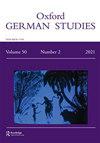Woran erkennt man einen Klassiker? Frontispize und Kupfertitel als Klassifizierungsinstrumente in Werkausgaben Zeitgenössischer Autoren im 18. Jahrhundert
IF 0.1
3区 文学
0 LITERATURE, GERMAN, DUTCH, SCANDINAVIAN
引用次数: 0
Abstract
Der Kostenaufwand für Buchillustrationen, den Verleger und Käufer auf sich nehmen, soll häufig zugleich ästhetische Kostbarkeit signalisieren. Eine spezifischere Wertauszeichnung als ‘Klassiker’ ist zudem möglich vermittels bestimmter Bildsemantiken. Der Beitrag untersucht, wie Frontispize und Kupfertitel im ausgehenden 18. Jahrhundert dafür eingesetzt wurden, dem Publikum ad oculos zu demonstrieren, dass die zeitgenössische deutsche Literatur nun zu Klassikerhöhen aufgestiegen sei. Untersuchungsgegenstand sind sowohl verschiedene Darstellungsstrategien als auch das jeweils ausgedrückte Klassikerverständnis: Klassizität wurde sowohl durch bildliche Antikisierung suggeriert wie auch als Resultat gegenwärtig oder sogar zukünftig vollzogener Dichter-Verehrung behauptet. Die These des Beitrags lautet: Für die seit der Jahrhundertmitte sehnsüchtig erwarteten ‘deutschen Klassiker’ und deren käuflichen Erwerb ließ sich durch augenfällige Demonstrationen ihrer Verehrungswürdigkeit und ihres Verehrtwerdens überzeugender werben als durch ein Referieren der ästhetischen oder literatursoziologischen, vor allem aber kontroversen Debatten, welche die Spezialisten der Literaturkritik führten. The expense for book illustrations, which publishers and buyers undertake, is often intended to signal aesthetic preciousness at the same time. A more specific marking of value as a ‘classic’ is also possible by means of certain pictorial semantics. This article examines how frontispieces and copperplate titles were used in the late 18th century to demonstrate ad oculos to the public that contemporary German literature had now risen to the heights of classicism. The object of investigation is both the various strategies of representation and the understanding of the classics expressed in each case. The status of a classic was both suggested by pictorial antiquisation and asserted as the result of present or even future veneration. The thesis of this article is that the ‘German classics’, which had been eagerly awaited since the middle of the 18th century, could be advertised more convincingly through eye-catching demonstrations of their venerability and veneration than by referring to the aesthetic or literary-historical, but above all controversial, debates conducted by specialists in literary criticism.你是怎么认出经典的?在18年当代作家的作品版本中,作为分类工具的Frontispiece和铜标题。100年
出版商和买家承担的书籍插图成本通常是为了同时表明美学价值。通过某些图形语义,对价值观进行比“经典”更具体的标记也是可能的。本文探讨了Frontispize和Copper标题在即将离任的18岁中的作用。在19世纪,它被用来向公众展示当代德国文学已经上升到古典主义的高度。研究的主题既是不同的表现策略,又是对古典主义各自表达的理解:古典主义既是由古代绘画提出的,又被认为是当前甚至未来诗歌崇拜的结果。这篇文章的论点是:自本世纪中叶以来备受期待的“德国经典”及其购买,可以通过对其崇敬和崇敬的明显展示来宣传,而不是通过美学或文学社会学的展示,但最重要的是,有争议的辩论,这就造就了文学批评专家。出版商和买家承担的书籍插图费用通常是为了同时表明美学的准确性。通过某些图形语义,也可以将价值更具体地标记为“经典”。本文探讨了18世纪末如何使用正面作品和铜版标题向公众展示当代德国文学已经上升到古典主义的高度。研究的对象是在每一个案例中表达的各种表现策略和对经典的理解。一部经典作品的地位既是由绘画的古董所暗示的,也是由现在甚至未来的崇敬所断言的。这篇文章的论点是,自18世纪中期以来一直备受期待的“德国经典”,可以通过引人注目的对其崇敬和崇敬的展示,而不是通过提及美学或文学历史,但最重要的是,文学批评专家进行的有争议的辩论,来更令人信服地宣传它们。
本文章由计算机程序翻译,如有差异,请以英文原文为准。
求助全文
约1分钟内获得全文
求助全文
来源期刊

OXFORD GERMAN STUDIES
LITERATURE, GERMAN, DUTCH, SCANDINAVIAN-
CiteScore
0.10
自引率
50.00%
发文量
2
期刊介绍:
Oxford German Studies is a fully refereed journal, and publishes in English and German, aiming to present contributions from all countries and to represent as wide a range of topics and approaches throughout German studies as can be achieved. The thematic coverage of the journal continues to be based on an inclusive conception of German studies, centred on the study of German literature from the Middle Ages to the present, but extending a warm welcome to interdisciplinary and comparative topics, and to contributions from neighbouring areas such as language study and linguistics, history, philosophy, sociology, music, and art history. The editors are literary scholars, but seek advice from specialists in other areas as appropriate.
 求助内容:
求助内容: 应助结果提醒方式:
应助结果提醒方式:


